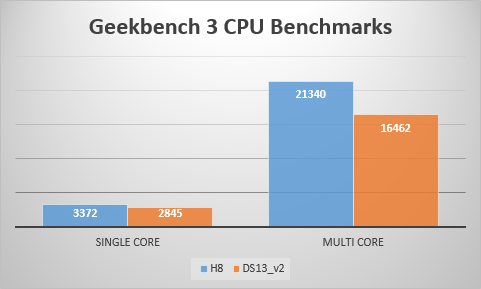Microsoft has described the H series VM as “a new family specifically designed to handle high performance computing workloads such as financial risk modeling, seismic and reservoir simulation, molecular modeling and genomic research. They are based on the Intel Xeon E5-2667 v3 Haswell 3.2 GHz (3.6 GHz with turbo) with DDR 4 memory.” The machines themselves have high core count, memory, and large local SSD storage. They do not offer any premium disk support, so the thought of using it for other scenarios quickly fall out of play. Their two higher end SKUs (H16r and H16mr) support Remote Direct Memory Access (RDMA) which allows a computing node to access the memory directly from another computing node without involving the operating system or CPU. This is the first time Microsoft has rolled out such technology to their VMs.
I ran a quick benchmark on a single H8 VM (Intel Xeon E5-2667 v3 @ 6.38 GHz 1 processor, 8 cores) and compared the results to the DS13_v2 (Intel Xeon E5-2673 v3 @ 4.75 GHz 1 processor, 8 cores) from my previous blog post here. The CPU scored higher as one would expect.

The local SSD results were rather quite surprising. The Q32T1 results are read/writes with multi queues & threads which would most likely be used in a HPC scenario.

The public cloud truly shines in the HPC market as having all the infrastructure on prem requires a heavy initial investment and when considering costs outside of infrastructure such as location, electrical, cooling and support. Also, being able to easily scale up or down depending on current workload requirements is something that is simply not possible with on prem-infrastructure. More information on the H series VMs can be found here.